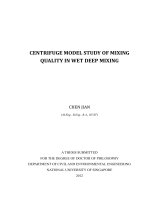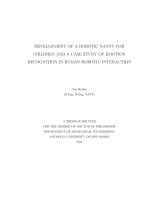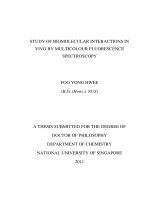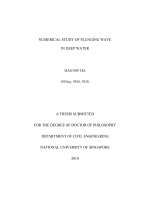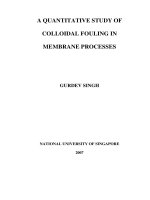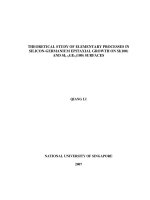Study of biomolecular interactions in vivo by multicolour fluorescence spectroscopy
Bạn đang xem bản rút gọn của tài liệu. Xem và tải ngay bản đầy đủ của tài liệu tại đây (2.04 MB, 128 trang )
STUDY OF BIOMOLECULAR INTERACTIONS IN
VIVO BY MULTICOLOUR FLUORESCENCE
SPECTROSCOPY
FOO YONG HWEE
(B.Sc.(Hons.), NUS)
A THESIS SUBMITTED FOR THE DEGREE OF
DOCTOR OF PHILOSOPHY
DEPARTMENT OF CHEMISTRY
NATIONAL UNIVERSITY OF SINGAPORE
2011
i
This work was performed in the Department of Chemistry at the National
University of Singapore under the supervision of Associate Professor Thorsten
Wohland, and in the Institute of Medical Biology, Agency for Science, Technology
and Research, under the co-supervision of Associate Professor Sohail Ahmed,
between August 2006 to July 2011. The translocation project of p21 and PCNA was
done in collaboration with Dr Carsten Schultz in the European Molecular Biology
Laboratory (Heidelberg), between October 2009 to January 2010. Part of the PIE-
FCCS measurements was performed in Ludwig-Maximilians-Universität München in
collaboration with Professor Don C. Lamb in December 2009.
The results have been partly published in
Y. H. Foo, V. Korzh, and T. Wohland. Fluorescence Correlation and Cross-
Correlation Spectroscopy Using Fluorescent Proteins for Measurements of
Biomolecular Processes in Living Organisms. 2011. Springer Series on
Fluorescence, Online First
TM
, 31 March 2011.
Shi, X., Y. H. Foo, T. Sudhaharan, S. W. Chong, V. Korzh, S. Ahmed, and T.
Wohland. 2009. Determination of dissociation constants in living zebrafish
embryos with single wavelength fluorescence cross-correlation spectroscopy.
Biophys J 97:678-686.
Sudhaharan, T., P. Liu, Y. H. Foo, W. Bu, K. B. Lim, T. Wohland, and S. Ahmed.
2009. Determination of in vivo dissociation constant, K
D
, of Cdc42-effector
complexes in live mammalian cells using single wavelength fluorescence cross-
correlation spectroscopy. J Biol Chem 284:13602-13609.
Foo Yong Hwee
17/08/2011
ii
Acknowledgements
I started off with only an analytical chemistry background. Thus, this thesis in the
field of biophysics would not be possible without the help of many individuals.
I would like to express my special thanks to my supervisor Associate Professor
Thorsten Wohland for the opportunities to work in these projects. The support,
guidance, patience and freedom he has given me are greatly appreciated. I have
gained a lot from his passion for research and his eye for details.
I am very grateful to my co-supervisor Associate Professor Sohail Ahmed for
making me a part of his lab and showing me the ropes of molecular cell biology. As I
have spent most of my time in his lab, I am lucky to have his support, patience and
guidance. I have learned a great deal about molecular biology and imaging from the
numerous discussions with him.
I am greatly thankful to Professor Ernst H. K. Stelzer for hosting me during my
short-term EMBO fellowship in the European Molecular Biology Laboratory
(EMBL). I would like to thank Dr Carsten Schultz and the technical assistance given
by Dr Alan Piljic and Dr Malte Wachsmuth in the EMBL for the project during the
stay.
I am grateful for the collaboration and support given by Professor Don C. Lamb of
Ludwig-Maximilians-Universität München during my short stay in his lab. Special
thanks to Nikolaus Naredi-Rainer and Dr Matthias Höller, for setting up the
instruments during that period.
I wish to thank all the colleagues from the Biophysical Fluorescence Laboratory in
the National University of Singapore and from the Neural Stem Cells group in the
Institute of Medical Biology for their discussions, guidance, patience and friendship.
In particular, Dr Liu Ping for the guidance in SW-FCCS; Dr Shi Xianke for the
zebrafish embryo measurements; Dr Thankiah Sudhaharan and Dr Eric Lam Chen
Sok for the guidance and discussion in molecular cell biology.
Last but not least, I would like to thank my parents for their love, support and
understanding.
iii
Table of Contents
Acknowledgements ii
Summary vii
List of Tables ix
List of Figures x
Lists of Symbols and Acronyms xii
1 Introduction 1
2 Theory and Instrumental Setup 11
2.1. Fluorescence Correlation Spectroscopy (FCS) 13
2.1.1. Fluorescence fluctuations 13
2.1.2. The Autocorrelation function 14
2.1.3. Theoretical ACF models 15
2.2. Fluorescence Cross-Correlation Spectroscopy (FCCS) 23
2.2.1. The Cross-Correlation Function 24
2.3. Applying FCS and FCCS in vivo 27
2.3.1. Background corrections 27
2.3.2. Crosstalk 30
2.3.3. Optimizing measurement conditions 31
2.4. Instrument Setup and SW-FCCS 31
iv
3 Quantitation Using Cross-Correlation Ratios: A Simulation Study 34
3.1. Introduction 34
3.2. Materials and Method 36
3.3. Cross-correlation ratios for 1:1 binding 37
3.4. Quantitation for a dimerization system 41
3.5. Summary 43
4 Determination of Dissociation Constants in Living Cells 45
4.1. Interaction of Cdc42 with IQGAP1 in living cells and zebrafish embryo. 47
4.1.1 Theory 47
4.1.2. Cell culture 49
4.1.3. Plasmids 49
4.1.4. Instrumentation and data analysis 50
4.1.5. FCCS Calibration 50
4.1.6. Controls 52
4.1.7. Interaction of Cdc42
T17N
with IQGAP1 53
4.1.8. Interaction of Cdc42
G12V
with IQGAP1 54
4.1.9. Comparison of the results in CHO cells and zebrafish embryos 56
4.1.10 Conclusion 58
4.2. Interaction of p21 with PCNA in Living Cells with FCCS and
Translocation 59
v
4.2.1 Introduction 59
4.2.2 FCCS Instrumentation 60
4.2.3. Plasmids and cell culture 60
4.2.4. Translocation 61
4.2.5. FCCS measurements 62
4.2.6 Conclusion 63
5 Factors Affecting Fluorescence Cross-Correlation Spectroscopy 65
5.1. Introduction 65
5.2. Theory 66
5.2.1. Cross-correlation volume 66
5.2.2. CCF ratios 68
5.2.3. Pulsed interleave excitation-FCCS and FRET 69
5.3. Materials and Methods 71
5.3.1. Plasmids and cell cultures 71
5.3.2. Cycloheximide chase experiment 72
5.3.3. SW-FCCS Instrumentation 72
5.3.4. Obtaining the brightnesses of GFP dimers 72
5.3.5. Pulsed interleave excitation-FCCS Instrumentation 73
5.4. Results and Discussions 74
5.4.1. Calibration of SW-FCCS observation volumes with a single dye.74
vi
5.4.2. Photophysical properties of tandem FPs change the auto- and
cross-correlation amplitudes 75
5.4.3. Non-fluorescent FPs and their influence on the FCCS data 79
5.4.4. Influence of FRET on the amplitudes 83
5.4.5. Determination of effective observation volumes and correction
parameters 85
5.4.6. Influence of non-fluorescent labels on binding experiments 87
5.4.7. Influence of endogenous labels on binding experiments 90
5.4.8. Experimental K
d
(mRFP against mCherry) 93
5.4.9. Experimental K
d
with endogenous proteins 94
5.5. Conclusion 95
6 Conclusion and Outlook 97
Bibliography 102
vii
Summary
Fluorescence correlation spectroscopy (FCS) and its modality fluorescence cross-
correlation spectroscopy (FCCS) are single molecule sensitive optical tools to study
mobility, concentrations and interactions. Due to their non-invasive nature, they are
gaining popularity in studying molecular processes in vivo. The aim of this thesis is to
apply and develop single-wavelength-FCCS (SW-FCCS), a variant of FCCS, to study
protein-protein interactions in vivo. The thesis is organized into the following
chapters:
Chapter 1 starts with discussing the importance of green florescent proteins (GFP)
in modern cell biology. The advent of GFP led to the development of many optical
tools to study molecular interactions and dynamics in vivo. A review of the different
modalities of FCS/FCCS is presented and what are the different types of GFP mutants
that are commonly used in FCCS.
Chapter 2 introduces the principles and instrumental setup of FCS and FCCS. It
discusses the additional corrections and conditions when applied in vivo.
Chapter 3 discusses the cross-correlation ratios, which is commonly used to
quantitate binding. It was shown, using a series of simulations, that these cross-
correlation ratios are dependent on the K
d
of the binding, concentration range and the
relative amount of red to green labeled molecules in the system.
Chapter 4 applies SW-FCCS to quantitate protein-protein interactions. It is
divided into two parts. In the first part, the binding between a small GTPases protein
viii
Cdc42, and one of its effectors, IQGAP1, is investigated. The K
d
of the binding in cell
culture was compared with that in zebrafish embryo. In the second part, SW-FCCS is
applied to study interaction between two proteins, p21 and PCNA, which are involved
in DNA replication and DNA damage repair.
Chapter 5 addresses issues which constantly surface during measurements in vivo
but are not studied extensively. These issues include mismatch in effective volumes,
non-fluorescent fluorescent labels, FRET, photobleaching and endogenous proteins.
All these factors influence the quality of the determined K
d
. Major findings include
quantitating the fraction of non-fluorescent red fluorescent proteins (mRFP and
mCherry) and investigating the relationship of K
d
with non-fluorescent labels both by
simulations and experiments.
Chapter 6 concludes and presents outlook for future FCS and FCCS research.
ix
List of Tables
4.1 Summary of FCCS study in zebrafish muscle fiber and CHO cells 57
5.1 SW-FCCS measurements of different tandem fluorescent proteins 78
x
List of Figures
2.1 Overview of the processes in FCS 12
2.2 ACFs in under different conditions 22
2.3 Principle of FCCS 24
2.4 Single-wavelength FCCS (SW-FCCS) setup 32
3.1 Simulations of various complex ratios at K
d
= 20 nM 38
3.2 Simulations of various complex ratios at K
d
= 500 nM 40
3.3 Simulations of F
dimer
at K
d
= 20 nM 43
4.1 SW-FCCS measurement of 10 nM R6G 51
4.2 SW-FCCS measurements of controls 52
4.3 SW-FCCS measurements of Cdc42
T17N
or Cdc42
G12V
with IQGAP1 55
4.4 Interaction of Cdc42mutants with IQGAP1 in zebrafish embryos 56
4.5 An illustration of the A4 annexin translocation system in a cell 59
4.6 Confocal images of EGFP-p21 and A4-mCherry-PCNA 61
4.7 Measurements of EGFP-p21 and A4-mCherry-PCNA 63
5.1 SW-FCCS experiments of a single fluorophore in two different detection
channels 75
5.2 SW-FCCS measurements in CHO cells with mRFP-GFP tandems 77
5.3 Histograms of dimer cps 80
xi
5.4 SW-FCCS measurements in CHO cells under different conditions 82
5.5 PIE-FCCS experiments 84
5.6 Binding studies in the presence of non-fluorescent fusion proteins 90
5.7 Binding studies in the presence of endogenous proteins 92
5.8 Experimental K
d,app
plots generated by SW-FCCS 95
xii
Lists of Symbols and Acronyms
B Background
C Concentration
D Diffusion coefficient
Brightness or counts per particle per second (cps)
G(0) Amplitude of the correlation function
G
G
(0) Amplitude of the autocorrelation function of the signal in the
green channel
G
R
(0) Amplitude of the autocorrelation function of the signal in the
red channel
G
GR
(0) Amplitude of the cross-correlation function
G(
) Correlation function
N Average number of particles detected
N
A
Avogadro constant
Delay time
D
Diffusion time
V
eff
Effective volume
ω
0
Lateral distance from the centre of the laser focus to where the
intensity has decay to 1/e
2
xiii
z
0
Axial distance from the centre of the laser focus to where the
intensity has decay to 1/e
2
ACF Autocorrelation function
BiFC Biomolecular fluorescence complementation
CCF Cross-correlation function
CHO Chinese hamster ovary
cps Counts per particle per second or
DNA Deoxyribonucleic acid
FP Fluorescent protein
GFP Green fluorescent protein
EGFP Enhanced green fluorescent protein
EGFR Epidermal growth factor receptor
FP Fluorescent protein
FRET Förster resonance energy transfer
mEGFP Monomeric enhanced green fluorescent protein (A206K
mutant)
mRFP Monomeric red fluorescent protein 1
mRNA Messenger Ribonucleic acid
RFP Red fluorescent protein
wt Wild Type
1
Chapter 1
Introduction
Fluorescence imaging and spectroscopy are important techniques in the area of
modern biology. Today, fluorescent tagging of biomolecules allows researchers to
monitor even single molecules of interest in organisms. This advance has been
possible because of the advent of green fluorescence protein (GFP), which allowed
genetic labeling of proteins within cell cultures or in vivo in a selective and specific
manner. GFP was first extracted from the jellyfish Aequorea aequorea by Shimomura
and colleagues together with the chemiluminescent protein aequorin [1]. In 1994,
Chalfie and colleagues managed to express GFP in Escherichia coli and
Caenorhabditis elegans as a biomarker [2]. This immediately opened up the
possibility of using GFP to monitor gene or protein expression and localization in
organisms. This wild type GFP has two peaks in its excitation spectrum which are at
396 nm and 475 nm. While the 475 nm peak, which has a smaller amplitude than the
396 nm peak, is suitable for the commonly used 488 nm argon line and filter sets, the
excitation extinction coefficient is low (7150 M
-1
cm
-1
) [3]. Hence, many mutations of
wt GFP were made to increase the excitation extinction coefficient [3-7]. One of the
most successful groups of researchers contributing to this field was Tsien and his
Chapter 1
2
team [3, 4, 8]. Currently, mutants of GFP can be found throughout the visible
spectrum [7, 9] which facilitate the monitoring of multiple proteins simultaneously.
Tagging GFP genetically to a protein enables one to map the role of the protein in
biological samples which otherwise would be invisible. This technique has been
applied extensively in cells and organisms instead of fluorescent organic dyes and
quantum dots due to the 1:1 labeling ratio and the low toxicity level of many GFP
mutants in biological samples. If a GFP fused protein is involved in a cellular process,
for example cell division, then one can monitor the involvement of this protein both in
space and time during cell division. Other processes such as transport pathways, actin
structure and dynamics, chromosome replication and organization, gene expression to
name but a few can be monitored. GFP labeling is so important and prevalent that the
2008 Nobel Prize in Chemistry went to Osamu Shimomura, Martin Chalfie and Roger
Y. Tsien for the discovery and development of GFP [10].
The advent of GFP leads to the development and applications of many optical
imaging and spectroscopy tools in biology. These tools have been helpful in
discovering molecular interactions, molecular dynamics and localization of
molecules. Among these many different processes in a cell, protein-protein
interactions play an important role in a cell system. As a cell functions through a
network of protein-protein interactions, it is vital to study these interactions as it
allows one to understand the role of a particular protein and its place in the whole
network. Many techniques, which are mainly biochemical in nature, are available to
detected protein-protein interactions. However, they are either in vitro methods or
qualitative in nature. For example, the commonly used co-immunoprecipitation
involves lysing the cell before using anti-bodies to pull down the target protein
complexes. Another technique, the yeast-two-hybrid system detects protein-protein
Chapter 1
3
interactions in vivo but it requires the proteins to be expressed in yeast which is not
the native environment for the protein of interest (unless it is a yeast protein).
Therefore there is a need to monitor protein-protein interactions using non-invasive
methods in the native cell environment and this is where the optical imaging and
spectroscopy tools fill the gap.
Fluorescence microscopy is most commonly used to monitor the expression of
proteins in cells. Due to its diffraction limited resolution of ~250 nm, it is not possible
to detect protein-protein interactions even if two proteins are localized in the same
pixel of an image. Although there are microscopy techniques which break the
diffraction limit and reduce the resolution down to less than 100 nm [11, 12], the
resolution of the different techniques is still larger than the size of the complexes. The
most common fluorescence technique used to detect molecular interactions in cells is
based on Förster resonance energy transfer (FRET). FRET involves the transfer of
excitation energy from a donor molecule to an acceptor molecule within a distance of
~10 nm. Hence if FRET is detected, it is likely that the donor and acceptor molecule
are interacting due to the close proximity. The advantage of FRET is that, since the
FRET efficiency is dependent on the distance between the two fluorophores, the
technique can also be applied to determine intra- or inter-molecular distances.
Another technique which also make use of the close proximity of the interaction is
biomolecular fluorescence complementation (BiFC) [13]. The two proteins of interest
are tagged with fragments of a fluorescent protein which is non-fluorescent. When the
two proteins interact, the two halves of the fluorescent protein, which are close to
each other, form a fluorescent complex. Both FRET and BiFC are dependent on the
orientation of the fluorophores (or halves of the fluorophore). If they are not
orientated in the proper position, one cannot detect interaction even if the proteins are
Chapter 1
4
bound to each other. Also both techniques do not quantitate the strength of
interaction. In special cases such as the combination of fluorescence lifetime imaging
microscopy to FRET (FLIM-FRET), one can determine the amount of donor
molecules in complex which gives an estimate of the binding strength [14]. Binding
strength is typically represented by dissociation constant K
d
. A technique which
allows the determination of K
d
is fluorescence cross-correlation spectroscopy (FCCS)
[15].
FCCS investigates the synchronized fluorescence fluctuations of two different
fluorophores in order to detect biomolecular interactions. When the movements of
two molecules are synchronized, they are most likely to be interacting. FCCS is an
extension of fluorescence correlation spectroscopy (FCS). The basic principles of
FCS is based on extracting statistical information that is embedded within the
fluorescence fluctuations generated by the tagged molecules as they pass through an
illuminated observation volume. The processes creating the fluctuations in the
fluorescence signal can be due to photophysical properties of the label or movement
of the labeled molecules. FCS extracts this information by transforming the
fluorescence signal with a mathematical process known as autocorrelation to produce
an autocorrelation function (ACF). With a typical resolution of nanoseconds and
measurement times of seconds, processes happening between nanoseconds and
seconds contribute to the shape of the ACF. It is the high temporal resolution of FCS
which allows diffusion processes (microseconds to milliseconds) such as Brownian
diffusion [16], anomalous diffusion [17-19] and flow [20, 21] to be monitored. The
time taken for these molecules to diffuse through the observation volume, the
diffusion time, depends on the size of the molecules. Since the ACF also indicates the
amount of molecules undergoing a certain diffusion process, one can determine and
Chapter 1
5
quantitate the kinetics or affinity of molecular interactions based on the change in
diffusion characteristics [22-30]. In addition, fast processes (nanoseconds to
microseconds) such as triplet state dynamics [31-33], chemical reactions [34],
rotational diffusion [35-40] and photophysics of fluorescent proteins [41-43] can also
be monitored. The typical observation volume in a confocal FCS instrument is ~0.5
femtolitre (fL), small enough to allow resolution at the sub-cellular level. FCS
measurements have been performed in the cytoplasms, nuclei and membranes of
many common cell lines, bacteria and yeast. A further advantage is that FCS works
only in the concentration range from sub-nanomolar (nM) to a few micromolar (µM),
close to typical physiological concentration ranges and well below what is commonly
used in imaging.
While in FCS, only one species of fluorescent tagged molecule is monitored,
FCCS cross-correlates fluorescence signals generated by two different fluorophores to
produce a cross-correlation function (CCF). The CCF contains the information about
the interaction between the two molecules. This can be applied to quantitate the
fraction of molecules in complexes or the K
d
of molecular interactions. FCCS has
been applied to study enzyme activities [44-46], polymerase chain reaction [47], DNA
or RNA-protein interactions [48, 49], protein-protein interactions [50-56] and receptor
dimerization or oligomerization [57, 58]. Different schemes of FCCS exist. The most
common scheme involves using two lasers of different wavelengths to excite the two
different fluorophores which is termed dual-colour FCCS [15]. Single wavelength
FCCS (SW-FCCS), which only uses a single laser for the excitation of the two
fluorophore [59-62], was developed to remove the technical difficulty to align two
lasers in space. This single wavelength excitation FCCS can also be achieved using
two-photon excitation (TPE) [63-68]. Despite the different excitation schemes, the
Chapter 1
6
concept of FCCS is basically the same. The advantage of FCCS is that, unlike
methods that rely on FRET, it is independent of the relative position, orientation and
spectral overlap of the two fluorophores, and thus is less likely to produce false
negative results. Due to its non-invasive measurements, small detection volume, low
concentration working range and single molecule sensitivity, FCCS is suitable for the
quantitative determination of protein-protein interaction in living cells.
On the other hand, FCS/FCCS is still a relatively new technique in cell biology.
Despite FCS being first demonstrated in 1972 [34] and the concept of cross-
correlation being shown in 1989 [62], they suffered from poor temporal resolution,
signal-to-background and signal-to-noise ratio due to technological limitations. In
1993, Rigler and colleagues used a strongly focused laser and smaller pinhole size in
addition to better technology to produce a diffraction limited observation volume of
less than 1 fL [69], demonstrating that FCS is a viable technique. This lead to the
development of FCCS in 1997 [15]. Earlier studies were performed in vitro and it was
only in the mid-2000s when FCCS started to be applied in living cells [45, 46, 50, 70].
This was followed by the recent applications in organisms [55, 71].
FCS/FCCS have developed from a single confocal acquisition spot to two-foci
[72-74] and multiple foci excitation and detection [75-81] for the simultaneous
detection of different regions of the sample. Camera based detection when coupled
with total internal reflection (TIR) and single-plane illumination microscopy (SPIM),
are now able to simultaneously record thousands of measurements in different
locations [82-84]. Another modality is scanning FCS/FCCS, which either scans the
sample in a line [85-91] or circular pattern [92-96]. The information obtained from
scanning contains spatial and temporal components of the process while conventional
FCS/FCCS only contains the temporal components. Scanning also allows the
Chapter 1
7
measurement of very slow or immobile molecules [94]. It has been used to study
protein dynamics in C. elegans before asymmetric cell division [95] and to study
blood flow in zebrafish embryos [90]. Recently, this scanning FCS/FCCS is combined
with two-foci-FCS and alternating excitation, for membrane studies with the
capability to correct for membrane movements [89, 97, 98]. They have being applied
in zebrafish embryos to study receptor-ligand interaction [71]. Many of these
modalities are driven by the need to simultaneously probe spatial interactions and
dynamics across a biological sample. Other developments included the development
of better and faster software correlators [99, 100] and curve fitting algorithms [101].
Despite the technological advancements, performing single molecule sensitive
measurements such as FCS/FCCS in vivo is a challenge. The background
autofluorescence of other molecules in a cell sometimes interfere with the
measurement. On top of this, the commonly used GFP mutants are low in brightness
and less photostable when compared to organic dyes resulting in less photons being
collected. There is also the issue of crosstalk in a dual or multi-label system. Crosstalk
is typically the photons from the long emission tail of a “green” fluorophore being
detected in the “red” detection channel which is for the “red” fluorophore. This
complicates the quantification of the “red” molecules. Fortunately, background
contribution and crosstalk can be corrected for by calibrations [53, 55, 102]. Crosstalk
can also be prevented by using alternative excitation and detection scheme such as
alternating excitation-FCCS [70, 103-105] while background can be filtered by
fluorescence lifetime correlation spectroscopy (FLCS) [106-108].
Although many GFP mutants are available for imaging, only a few are suitable for
FCCS measurements mainly due to poor photostability, presence of complex
photodynamics, poor brightness and broad emission spectra (causing crosstalk). These
Chapter 1
8
issues may be irrelevant or insignificant in imaging, but they do influence the quality
of the FCS data significantly. One of the more commonly used GFP variants is the
enhanced GFP (EGFP) from Clontech Laboratories which was named GFPmut1 in
the original publication [5]. The important mutations in EGFP which made it so
widely used are the double-amino-acid substitution of Phe-64 to Leu and Ser-65 to
Thr (F64L, S65T). This changed the two main excitation peaks of 395 nm and 470 nm
in wt GFP to a single excitation maximum of 488 nm in EGFP. This made it popular
with the 488 nm line from an argon laser. In addition, the mutant shows a 35 times
fluorescence intensity increase compared to the wild type. GFP is known to form very
weak dimers [109, 110], hence the monomeric version of EGFP (mEGFP) which
includes an A206K mutation is recently used in FCS/FCCS studies [111, 112].
Red fluorescent proteins (RFPs) are widely used with EGFP in FCCS [50, 51, 53-
57, 112-114]. RFPs generally have emission spectra far away from the emission
spectra of GFPs resulting in the reduction of crosstalk. Although there are many RFPs
[9], mRFP and mCherry are the most commonly used. mRFP [115] is the monomeric
version made from DsRed, a tetrameric red FP [116, 117]. mCherry is an improved
version of mRFP with a faster maturation rate and increased photostability compared
to mRFP [8]. However, red FPs are well known to be less photostable than EGFP. In
addition, they have issues such as complex photodynamics and non-fluorescent
fraction [53, 118, 119] and can interfere with the fitting of the ACF obtained from
FCS experiments [119]. Nevertheless, they are required to partner EGFP in FCCS
applications. Other FPs such as the enhanced yellow FP (YFP) is seldom used as it
has complex photodynamics and poorer photostability compared to EGFP [42]. A
recently developed FP, mKeima, with a large Stokes shift can be coupled with
enhanced cyan FP to perform SW-FCCS [120].
Chapter 1
9
In summary, FCCS is still in the stages of development. In vivo application and
interpretation of the data still require attention and improvement. Therefore the aim of
this thesis is the application and development of FCCS to quantitate protein-protein
interactions in vivo. The thesis contains six chapters and is structured into the
following sections:
Chapter 2 introduces the basic principles and instrumentation of FCS and FCCS.
The autocorrelation and cross-correlation functions and their theoretical models will
be covered. Challenges faced when preforming FCCS in vivo will also be discussed.
This is followed by the basic setup of SW-FCCS.
Chapter 3 investigates the limitations of cross-correlation ratios which are used
commonly to quantitate molecular interactions. This is done by using simulations to
look at different conditions, in particular the difficulty of controlling protein
concentrations which is commonly encountered in vivo.
Chapter 4 applies FCCS to quantitate protein-protein interactions. It is divided
into two different studies. The first part investigates the interaction between a small
GTPase Cdc42 and its target protein IQGAP1. Small GTPases are molecular switches
in a cell which govern many cellular processes. The K
d
s of the interaction are reported
both in cell cultures and in zebrafish embryo. The aim is to investigate if the binding
is different or not in a 2D cell culture and in an organism. The second part applies
FCCS to quantitate the interaction between p21 and PCNA. They are proteins which
play an important role in DNA replication and DNA damage repair.
Chapter 5 investigates some of the factors which affect FCCS studies in vivo but is
usually overlooked. These issues include mismatch in effective volumes, non-
fluorescent fluorescent labels, FRET, photobleaching and endogenous proteins. All
Chapter 1
10
these factors influence the quality of the determined K
d
. Major findings include
quantitating the fraction of non-fluorescent RFPs (mRFP and mCherry) and
investigating the relationship of K
d
with non-fluorescent labels both by simulations
and experiments. The results show that these factors can be accounted for during
measurements.
Finally, chapter 6 concludes and presents outlooks for future research related to
FCS and FCCS.
11
Chapter 2
Theory and Instrumental Setup
2.1. Fluorescence Correlation Spectroscopy (FCS)
The principle of FCS is based on detecting fluorescent particles diffusing in and
out of an observation volume. The observation volume can take on different sizes and
shapes depending on the illumination and detection setup. In a typical confocal
microscope, the observation volume is created using one-photon excitation and a
pinhole to achieve axial sectioning of the observation volume. This confocal volume
is an oblong shaped laser focal volume on the order of femtolitres (fL). As fluorescent
particles transit the observation volume (Fig. 2.1a), fluorescent fluctuations are
recorded (Fig. 2.1b). The fluctuation contains information about the movement of the
fluorophore thorough the observation volume as well as any phenomenon that
changes the fluorescence property of the fluorophore during this transition time. It
also indicates the average amount of particles detected within the observation volume.
However, it is very difficult to extract all these information just by analyzing the raw
fluorescence fluctuation. In order to extract the wealth of information from the
fluctuations, it is transformed by a normalized autocorrelation function (ACF) into a


